St Paul's Church, Auckland
St Paul's Church is an historic Anglican church, located on Symonds Street near the University of Auckland and Auckland University of Technology, in the central business district of Auckland, New Zealand. The church is the longest established parish in the city and has one of the largest Anglican congregations in Australasia.[1][2]
| St Paul's Church, Auckland | |
|---|---|
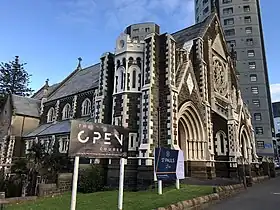 | |
| 36°51′16″S 174°46′06″E | |
| Location | 28 Symonds Street, Auckland |
| Country | New Zealand |
| Denomination | Anglican |
| Churchmanship | Charismatic Evangelical |
| Membership | 785 over 18 years old (2023) |
| Website | www |
| History | |
| Status | Church |
| Founded | 1841 |
| Founder(s) | Governor William Hobson |
| Dedicated | 1844, 1894 |
| Relics held | Carved stones from Westminster Abbey, Canterbury Cathedral, Yorkminster & St Paul's Cathedral, Bishop's throne, communion paten & chalice |
| Past bishop(s) | George Selwyn |
| Architecture | |
| Functional status | Active |
| Heritage designation | Category 1 Historic Place |
| Architect(s) | William Henry Skinner |
| Style | Gothic Revival |
| Years built | 1894-1895 |
| Specifications | |
| Materials | Rangitoto, Oamaru, Mt Somers & Timaru stone |
| Administration | |
| Diocese | Auckland |
| Parish | St Paul's Symonds Street |
| Clergy | |
| Bishop(s) | Ross Bay |
| Priest(s) | Matthew Bruns, Ian Yong, Nathan McLellan, Graham Black |
| Laity | |
| Director of music | Chris Cope |
| Treasurer | Wayne Silver |
| Churchwarden(s) | Bridget O'Malley, Dave Eaton |
| Business manager | Jennifer Cairns |
| Designated | 16 November 1989[1] |
| Reference no. | 650 |
The St Paul's foundation stone was laid by Governor William Hobson on 28 July 1841 and the first service was held on 7 May 1843. St Paul's also served as Auckland's Cathedral for over 40 years. The third and current building was formally consecrated by Bishop William Cowie on 1 November 1895, and is now registered as a Category 1 Historic Place.[3][4]
History
Early history

Now occupying its third building, St Paul's is known as the 'Mother Church' of Auckland as it is the oldest church community in the city and was founded within a year of the foundation of the city.[1][5][6] The first St Paul's was built in Emily Place, just off Princes Street, in 1841 where a plaque still marks the site of the beginning of the Christian church in Auckland.[4]
Old St Paul's was in the centre of the young colonial city, on a prominent ridge-top site on Point Britomart, close to the imperial garrison stationed at Fort Britomart, and near the remnants of the old Rangipuke pā where Ngāti Whātua had defended their rohe during the Musket Wars of the 1820s. St Paul's was the seat of the Bishop of New Zealand, the Right Reverend George Selwyn, and Auckland's wealthiest settlers worshipped there. The religion of British royalty, the Anglican faith was closely linked to colonial power. Many of St Paul's artefacts, such as the Bishop's Throne and a large collection of memorials, are connected to this time when Auckland was New Zealand's capital.[4][5][7][6]
Reverend John Churton was the first minister of St Paul's, occupying that role for 12 years. The Churton Memorial was built to his memory, close to the site of the original church building.[4] In 1863 the original building received extensive enlargements which doubled the seating capacity.[8]
During the height of the New Zealand Wars in the 1860s, St Paul's was used as a safe haven for women, children and the elderly; a traditional church role in times of strife.[9] After the war moved south, however, and Auckland expanded geographically, the congregation dwindled as attendees moved to the new suburbs of Epsom and Remuera, and St Matthew's in the City served the suburbs of Freemans Bay and Ponsonby, while the Church of the Holy Sepulchre served opulent Grafton.[10][5][11]
Early bicultural history
On 20 March 1840 in the Manukau Harbour area where Ngāti Whātua farmed, paramount chief Apihai Te Kawau, a friend of Samuel Marsden, signed Te Tiriti o Waitangi (the te reo Māori translation of the Treaty of Waitangi).[12] Ngāti Whātua sought British protection from Ngāpuhi as well as a reciprocal relationship with the Crown and the Church. Soon after signing Te Tiriti, Ngāti Whātua Ōrākei, the primary hapū and landowner in Tāmaki Makaurau, made a tuku (strategic gift) of 3,500 acres (1,400 hectares) of land on the Waitematā Harbour to Governor Hobson to establish his new capital, Auckland.[13][14][15][16] All three St Paul's buildings would be built on this land.[17]
When St Paul's was founded by Governor Hobson on 28 July 1841, hundreds attended the ceremony including Ngāti Whātua chiefs Apihai Te Kawau, Te Keene and a young Pāora Tūhaere, accompanied by over one hundred Māori warriors.[17]
On 19 July 1842, Bishop Selwyn, having learned te reo Māori himself, issued Rev Churton with a curacy license for 'the township of Auckland'. On the official printed license, Selwyn handwrote "Provided also that you shall use due diligence in the study of the language of the Native Inhabitants of New Zealand, and be ready when required to minister to their spiritual wants in like manner as to those of all the other inhabitants of your District without distinction of persons". However, St Paul's first vicar, who was originally sent by the New Zealand Company, was mainly concerned with European settlers, and refused to learn te reo.[17]
Bishop Selwyn opened St Paul's Church over four services on 7 May 1843. He later wrote, "The services began with a native congregation at nine; some of whom having only heard of the opening on Saturday evening, paddled a distance of twelve miles by sea during the night, in order to be present. The greater number were in full European clothing, and took part in the Church service, in a manner which contrasts most strikingly with that of the silent and unkneeling congregations of the English settlers." St Paul's then held four Sunday services weekly, serving both Māori and European congregations, with two services conducted in te reo Māori and two in English.[17]
The 1845–1846 Northern War in and around the Bay of Islands, caused by the difference in understanding between the English language Treaty of Waitangi and te reo Māori Te Tiriti o Waitangi, lead to an expectation that Hone Heke would attack Auckland, and St Paul's was fortified with shutters with loopholes. After hearing rounds of gunfire, the women and children of the town "were put into St Paul’s Church for safety, the one building easily holding the small population then here" and a military guard was posted for the night. The gunfire which caused the unnecessary panic turned out to be "over the body of a chief who had died during the day".[17]
The increasing European population of Auckland put pressure on Māori land and society, straining relations, leading to the city's second Anglican church, St Barnabas being opened in 1849 specifically for Māori.[17]
St Paul's was the pro-cathedral of Bishop of New Zealand for Selwyn's entire 28 year tenure. The New Zealand Church Missionary Society (CMS) criticised Selwyn for being ineffective in training and ordaining clergy – especially Māori. It took him 11 years to ordain the first Māori Anglican minister, Rev Rota Waitoa, at St Paul’s on 22 May 1853, and 24 years to ordain a Māori priest. Selwyn went on to ordain seven more Māori clergy at St Paul's, but his high church ways were blamed for undermining the work of the CMS and damaging Māori enthusiasm for Christianity.[17]
When Churton died in 1853, Selwyn appointed Rev John Frederick Lloyd to replace him. Lloyd was the opposite of Churton – a personal friend of Selwyn with respect for Māori, who spoke te reo, and had tutored mixed Māori and European classes at St John's College. Together they tried to create a bicultural house of worship.[17]
By 1859, Ngāti Whātua Ōrākei, who had given two further land tuku (strategic gifts) of 13,200 acres (5,342 hectares) to the Crown, had lost most of their remaining land through speculators. The 700-acre Ōrākei block was all that remained. Within a century, this too was compulsorily acquired by the Crown (apart from a cemetery).[18][16]
Selwyn and Lloyd generally advocated for Māori rights and were often critics of the unjust and reckless land acquisition practices that led to the New Zealand Wars. However, their support of the Invasion of the Waikato as chaplains, damaged their and the church's relationship with Māori, which is still felt today.[17]
Old St Paul's was considered a garrison church, but when the first regimental colours unfurled in New Zealand were donated to the church, Lloyd turned them down so "no jealousies of race or feelings of hostility should ever be permitted to enter, but where men should remember only that they are one in Christ".[17]
When the first St Paul's building was demolished, various political, military, clergy and settler memorials were kept, but the only direct reference to Māori was a plaque mentioning the 'hostile Maoris at Rangariri [sic]'.[17][7]
Changing locations
.gif)
The original Emily Place church was demolished in 1885, when Point Britomart was quarried away.[19]
A temporary wooden church, designed by William Skinner, was built on the corner of Short Street and Eden Crescent while a permanent church site was identified.[20] That temporary church is now the Tātai Hono marae, part of the Church of the Holy Sepulchre.[21][11]
Only the present site, halfway up the Symonds Street hill on the same ridge as the original church, was considered large and central enough for the planned church. It also placed it near Auckland's oldest street, Karangahape Road, which by the 1880s was a thriving thoroughfare and shopping precinct for both Māori and Pākehā. The road was a traditional walking track along the ridge from Ōwairaka (Mt Albert) to Ōrākei for Ngāti Whātua. The official municipal burial ground; the Symonds Street Cemetery was also nearby, on the corner of K’Road and Symonds Street.[5][22][23]
The new church building was dedicated in 1894, without the corner tower and steeple that were part of Skinner's design. The Long Depression had inhibited building such a monumental church. The interior was kept plain, apart from the rose window temporarily filled with coloured cathedral glass and the artefacts gifted by Selwyn.[5][19][24]
20th century
The appointment of Reverend Cecil Watson in 1908 led to St Paul's being revitalised as a stronghold of Anglo-Catholicism in a largely puritanical city. Watson, and his successor Samuel Corbin shaped the church for a half-century, introducing Sung Mass, choral music and the concept of spiritual healing, which received some resistance.[5][20]
In 1936 the temporary wooden chancel was replaced with today's concrete chancel, that is yet to be faced in stone.[1][25]
In 1954 Father Kenneth Prebble inherited a building and congregation both in a poor state, and for the next 20 years he reestablished St Paul's as a centre of Anglo-Catholicism. In the mid-1960s Prebble looked beyond the norm in terms of high church Anglican practise and embraced a revival of the Holy Spirit. Polarising the congregation, St Paul's became Spirit-focused, evangelical and contemporary while maintaining its Anglo-Catholic theology. Through its popular music, and a regular coffee-shop outreach to students and young people, Prebble and his successor Father David Balfour, helped create a church with city-wide and international impact through the 50s and 60s.[26][27]
From 1956 to 1973 many repairs and additions were made to the building, including: cleaning, repairing and replacing stonework; replacing the roof; and the addition of the Endean Memorial, Christ in Glory and Patteson Memorial stained glass windows.[25][28]
In 1974 the St Paul's Outreach Trust was formed and by the end of 1976 had produced three records sung by the St Paul's Singers entitled Songs for Prayer & Praise, Arise my Love and Harvest of Joy, plus songbooks including New Glory.[27][26][29] However, in the 1970s, the Anglo-Catholicism that had provided the theological framework for the spiritual and social justice revival of the 50s and 60s at St Paul's "dissolved into a bundle of conflicting theologies without strong leadership or good biblical teaching".[5]
During the 1980s and 1990s the parish, with the help of its first Māori curate Wally Te Ua, took steps towards a "more significant understanding of biculturalism" and a Friday night gospel service was established which became an outreach to immigrant families and students from Asian countries. The parish also continued taking an active role in supporting women clergy. However, many congregants of the previous period moved away, and only a "tiny remnant" of Anglo-Catholics remained loyal to the church. In 2002 the parish roll had 46 members.[5][10][30][31]
21st century
During the late 1990s and early 2000s, many young New Zealanders became Christians or renewed their faith at St Mary's London. Returning home, they wanted a similar church in Auckland. With the blessing of the Bishop of Auckland, a team from St Mary's were invited in 2004 to set up new family and young people-focused services at St Paul's, Symonds Street. Reverend Mike and Bex Norris and a core group of about 80 people whom had previously attended St Mary's in London, oversaw huge growth, with 1,335 members on the parish roll by 2009.[30][31]
From 2009 to 2013, St Paul's produced the GLOW Carols by Glowstick event at Auckland's Vector Arena, with around 10,000 people attending each year.[32][33] A key part of the event were Christmas films produced by St Paul's including The Christmas Story which has had 4 million views on YouTube.[34][35] The 2012 documentary short film O Little Town of Bethlehem was shot in modern Bethlehem.[36][37][35] In 2012 St Paul's produced its debut live worship album titled GOD w/ US including the voices of around 800 worshippers gathered across three services.[38]
In 2013 St Paul's priest in charge Reverend Mathew Newton officially asked the Anglican Diocese of Auckland synod to divest from fossil fuel industries due to the threat of climate change. It agreed and became the first New Zealand institutional body to do so.[39][40]
In 2015 St Paul's published a hard cover book of personal testimonies and photos of 128 children, youth and adults from the church called Stories.[41]
From 2015 to 2019, St Paul's produced Alt Carols as an alternative Christmas experience, combining creative elements of music, art and design. Volume One of the remixed carols from the events was released as an album in 2017, Volume Two in 2019.[42]
From 2019 to 2022, St Paul's Restoration leader Esther Grant, heritage & conservation architects Salmond Reed Architects and structural & seismic engineers worked to repair, strengthen and refresh the church building. Seismic strengthening was needed to reach building standards changed after the 2011 Christchurch earthquake.[43][44] On 5 March 2020, Ngāti Whātua Ōrākei led a blessing for the work, and St Paul's thanked the descendants of Apihai Te Kawau for the gift of the land on which the church was built. Huge timelines telling the stories of Ngāti Whātua Ōrākei and St Paul's were installed side by side on the scaffold hoardings during the Phase 2 work that was completed in 2020. Future work planned includes renewing the main roof with slate, further increasing seismic strength, restoring the interior, installing stained glass in the clerestory and building the spire.[45][46]
In 2020, Reverend Dr Nathan McLellan was ordained as a priest into the tikanga Māori Te Pīhopatanga o Te Tai Tokerau and, uniquely, was then licensed by Bishop Ross Bay to minister at St Paul’s, which is a part of the tikanga pākehā Auckland Anglican Diocese.[47][44]
Due to government and diocese restrictions during the 2020 to 2022 COVID-19 pandemic, for a total 52 weeks St Paul's replaced services and events in its buildings with 400 pre-recorded and live online videos that received a total of 436,700 views, including its first online-only Christmas services in 2021.[48][47][35]
St Paul's has a staff of 20 which includes a priest in charge, three assistant priests, a worship leader, six other full time employees, four part time office employees, five additional Sunday workers and one contractor.[47][44]
In May 2023, Wellington Diocese Archdeacon Pete Watson was announced as the next vicar of St Paul's and will be joining the church in November or December.[49]
Discography
St Paul's Singers
- Songs for Prayer & Praise, album (1974)
- Arise my Love, album (1974)
- Harvest of Joy, album (1975)
- New Harvest, album (1981)[26]
St Paul's Music
- GOD w/ US, live album (2012)
- Creation's King, single (2014)
- Alt Carols, compilation EP (2016)
- Alt Carols, Vol. 1, compilation album (2017)
- Alt Carols, Vol. 1.5, compilation EP (2018)
- Alt Carols, Vol. 2, compilation album (2019)
- See Again (Bartimaeus), single (2020)
- You Are My Desire, single (2022)[50]
Bibliography
St Paul's Outreach Trust
- Arise my Love – song book (1974)
- Harvest of Praise (1975)
- New Glory – songs of renewal (1976)
- New Harvest (1980)
- To God be the Glory – the first 10½ years of the charismatic renewal in St Paul's (1981)
- A Brief History of St Paul's Symonds Street (1991)[29]
St Paul's
- St Paul's Stories (2015)[41]
Videography
SPAM (St Paul's Arts & Media)
- The Christmas Prophecy (2006)
- Google Earth Christmas (2006)
- Open (2007)
- The Open Post 1&2 (2007)
- Open – Alice (2007)
- Family – An Exploration (2007)
- The Big Little Easter Story 1&2 (2009)
- O Little Town of Bethlehem (2012)
- 766 Christmases (2013)
- Star of Wonder (2016)
- Gold Frankincense Myrrh (2017)
- Stained Historical Stories – Talks 1–4 (2018)
- This is Christmas (2019)
- Palm Sunday Reading (2020)
- Easter Sunday Reading (2020)
- Christmas, I Choose to Remember (2020)
- Common Christmas Questions (2020)
- The Stories of Advent 1–6 (2021)
- Jesus Meets His Mother (2022)[51]
St Paul's
- Life (2007)
- How We're Doing It (2009)
- Life Questions (2011)
- GLOW Event Opening (2011)
- Date My Mate NZ (2012)
- International Students (2013)
- Life Course (2013)
- Mike & Bex 10 Years (2013)
- Twins and Twins (2014)
- GLOW Promo (2014)
- Visual Identity (2018)
- Big Issues (2020)
- Restoration Update (2020)
- The Story of St Paul's (so far ...) (2021)
- The Open Course (2021)
- The Evening Service (2022)[52]
- 400 pre-recorded and live online service, prayer, youth and kids videos, during COVID-19 restrictions (2020–21)[53][54][55][47]
SPANK (St Paul's Arts 'n' Kids)
- When God Was Born (2008)
- Boys (2009)
- The Christmas Story (2010)
- Good News of Great Joy (2011)
- My Mum (20012)
- An Unexpected Christmas (2012)
- Star News Bethlehem (2013)
- The Story of the Whole Bible (2019)[56]
St Paul's Music
- GOD w/ US 1–14 (2012, 2014)
- Creation's King (2014)
- Alt Carols 1–5 (2016)
- See Again (Bartimaeus) 1&2 (2020)
- You Are My Desire (2022)[57]
Gallery
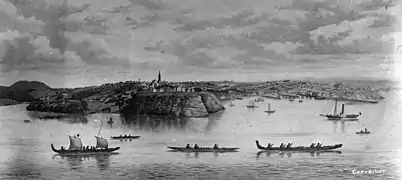 The Auckland waterfront with Māori waka and the original St Paul's building above Point Britomart, painted in 1852.
The Auckland waterfront with Māori waka and the original St Paul's building above Point Britomart, painted in 1852.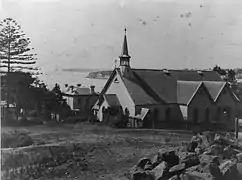 The temporary St Paul's building photographed in the 1880s.
The temporary St Paul's building photographed in the 1880s. Architect's perspective of the third building published in 1894, showing the unbuilt steeple.
Architect's perspective of the third building published in 1894, showing the unbuilt steeple.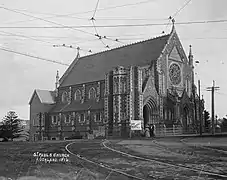 The third and current St Paul's building photographed in 1909.
The third and current St Paul's building photographed in 1909..jpg.webp) A St Paul's Evening Service, 2012.
A St Paul's Evening Service, 2012.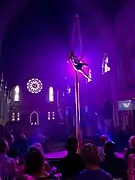 A St Paul's artist performs at Alt Carols for Christmas 2017.
A St Paul's artist performs at Alt Carols for Christmas 2017.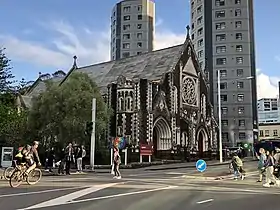 St Paul's on Symonds Street, 2018.
St Paul's on Symonds Street, 2018.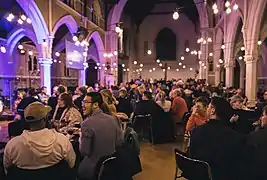 St Paul's community participating in an annual Quiz Night, 2019.
St Paul's community participating in an annual Quiz Night, 2019. Artists perform at Alt Carols for Christmas 2019.
Artists perform at Alt Carols for Christmas 2019.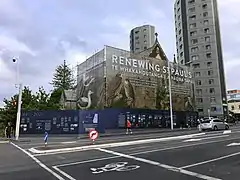 Building restoration scaffold wrap, including Ngāti Whātua Ōrākei and St Paul's timelines, 2020.
Building restoration scaffold wrap, including Ngāti Whātua Ōrākei and St Paul's timelines, 2020.
Windows gallery
 The large western Rose Window, with tracery designed by William Henry Skinner, glazed with cathedral glass, was the only stained glass installed during construction, 1895.
The large western Rose Window, with tracery designed by William Henry Skinner, glazed with cathedral glass, was the only stained glass installed during construction, 1895.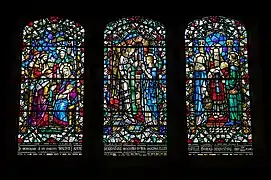 The northern Derbyshire Window, by James Powell and Sons a.k.a. Whitefriars Glass, in the Lady Chapel, depicting the Adoration of the Magi, Annunciation and Presentation of Jesus at the Temple, 1951.
The northern Derbyshire Window, by James Powell and Sons a.k.a. Whitefriars Glass, in the Lady Chapel, depicting the Adoration of the Magi, Annunciation and Presentation of Jesus at the Temple, 1951.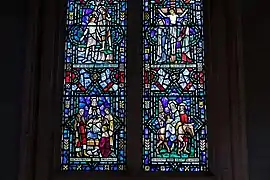 The southern Endean Memorial Window, by James Powell and Sons a.k.a. Whitefriars Glass, in the Requiem Chapel, depicting the Baptism of Jesus, Adoration of the Shepherds, Crucifixion of Jesus and Flight into Egypt, 1959.
The southern Endean Memorial Window, by James Powell and Sons a.k.a. Whitefriars Glass, in the Requiem Chapel, depicting the Baptism of Jesus, Adoration of the Shepherds, Crucifixion of Jesus and Flight into Egypt, 1959.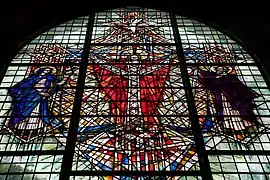 The large eastern Christ in Majesty Window, designed by Lawrence Lee, Royal College of Art, in the Chancel, depicting Mary, mother of Jesus, Jesus, Paul the Apostle, a dove symbolising the Holy Spirit and an eye symbolising God the Father, 1967.
The large eastern Christ in Majesty Window, designed by Lawrence Lee, Royal College of Art, in the Chancel, depicting Mary, mother of Jesus, Jesus, Paul the Apostle, a dove symbolising the Holy Spirit and an eye symbolising God the Father, 1967.
List of vicars
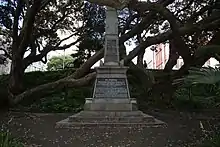
- Reverend John Frederick Churton 1841–1853 Emily Place
- Archdeacon John Fredrick Lloyd 1853–1870 Emily Place
- Canon Charles Mosely Nelson 1870–1908 Emily Place, Eden Terrace & Symonds Street
- Reverend Cecil Alexander Burns Watson 1908–1942 Symonds Street
- Canon Samuel Bertram Roberts Corbin 1942–1953 Symonds Street
- Father Kenneth Prebble 1954–1974 Symonds Street
- Father David Balfour 1975–1984 Symonds Street
- Reverend William Heald 1984–1993 Symonds Street
- Reverend Nicholas James Schoombee 1994–2001 Symonds Street
- Reverend Harvey Jackson Smith 2003–2005 Symonds Street
- Reverend Michael Charles Latham Norris 2005–2013 Symonds Street
- Reverend Jonathan Stephen Grant 2015–2022 Symonds Street
References
- "St Paul's Church (Anglican)". New Zealand Heritage List/Rārangi Kōrero. Heritage New Zealand. Retrieved 14 May 2019.
- "Jonathan Grant". Baker Publishing Group. Retrieved 31 October 2015.
- "History of the Diocese of Auckland". Anglican Diocese of Auckland. Retrieved 19 November 2016.
- "Churton Memorial". New Zealand Historic Places Trust. Retrieved 16 October 2013.
- "Where we've come from". Kate Hannah (Research Development Manager, The University of Auckland) St Paul's Church, Auckland. Retrieved 20 April 2019.
- Social and Economic Research and Monitoring team (2010). Brief history of Auckland's urban form. Auckland Regional Council. ISBN 978-1-877540-57-8.
- "St Paul's Church memorials, Auckland". New Zealand History. Retrieved 6 October 2018.
- "New Zealander". 7 September 1863. Retrieved 6 October 2018.
- "Auckland Star". 24 July 1926. Retrieved 30 September 2018.
- Eaglen, Jackie (1991). A Brief History of St. Paul's Symonds Street. St Paul's Outreach Trust.
- "Church of the Holy Sepulchre and Hall". New Zealand Heritage List/Rārangi Kōrero. Heritage New Zealand. Retrieved 13 May 2019.
- "Āpihai Te Kawau". New Zealand History. NZ Government. Archived from the original on 8 May 2019. Retrieved 27 June 2021.
- "Apihai Te Kawau". Ngāti Whātua-o-Ōrākei. Archived from the original on 11 August 2019. Retrieved 11 August 2019.
- "Tāmaki Herenga Waka: Stories of Auckland". Flickr. Auckland Museum. Archived from the original on 4 July 2021. Retrieved 3 May 2021.
- Report of the Waitangi Tribunal on the Orakei Claim (PDF) (Report) (1991 ed.). Wellington, New Zealand: The Waitangi Tribunal. November 1987. p. 23. ISBN 0-86472-084-X. Archived (PDF) from the original on 27 January 2021. Retrieved 5 May 2021.
- "Statement of evidence of Ngarimu Alan Huiroa Blair on behalf of the plaintiff" (PDF). ngatiwhatuaorakei.com. 2 June 2021. Retrieved 2 August 2021.
- Hawkins, Simeon. "King, Bishop, Knight, Pioneer: the Social and Architectural Significance of Old St Paul's Church, Emily Place, Auckland. 1841-1885" (PDF). The University of Auckland. Retrieved 30 November 2020.
- "The loss of the Orakei block". Waitangi Tribunal. Retrieved 8 December 2020.
- "New Zealand Herald". 28 July 1916. Retrieved 6 October 2018.
- Historic Buildings of NZ, North Island. Methven Publications (NZ) Ltd. 1983. pp. 112–113.
- "Tatai Hono: tying us together". Anglican Church in Aotearoa, NZ and Polynesia. Retrieved 25 May 2019.
- "Auckland's 175th anniversary: No easy road to street names". NZ Herald. Retrieved 6 October 2018.
- "Search the List | Symonds Street Cemetery | Heritage New Zealand". www.heritage.org.nz. Retrieved 3 August 2021.
- "STAINED Talk 2". St Paul's. Retrieved 19 August 2018.
- A Plan for the Preservation of St Paul's Church Auckland. Salmond Architects. 1998.
- Merritt, N.F.H. (1981). To God be the Glory. St Paul's Outreach Trust.
- "Kenneth Ralph Prebble". Stuff. Retrieved 30 September 2018.
- "STAINED Talk 3". St Paul's. Retrieved 7 October 2018.
- "Most widely held works by St Paul's Outreach Trust". OCLC WorldCat Identities. 6 January 2023. Retrieved 6 January 2023.
- "Unplugging the wells of blessing". Anglican Taonga. 2009. Retrieved 19 April 2019.
- "Parish roll statistics of Parish of St Paul's Church, Symonds Street". Anglican Diocese of Auckland, Archives. Retrieved 19 April 2019.
- "Carols by glow-stick at Vector Arena". NZ Herald. Retrieved 21 January 2018.
- "St Paul's, Glow - Carols by Glowstick". Image Central. Retrieved 8 September 2022.
- "The story of Christmas - A Kiwi version". NZ Herald. Retrieved 21 January 2018.
- "St Paul's Arts & Media". YouTube. Retrieved 21 January 2018.
- "Christmas in modern-day Bethlehem". News Hub. Retrieved 6 October 2018.
- "Roundup: Animated Nativity short; Bethlehem speaks; "Glory in the Darkest Place"; Norwegian jazz; gilding goldfinch". Art & Theology. Retrieved 6 October 2018.
- "GOD w/ US CD". St Paul's. Retrieved 20 April 2019.
- "Auckland challenged on fossil fuels". Anglican Commission on Communications. Retrieved 19 April 2019.
- "Auckland diocese to divest from fossil fuels". Anglican Communion News Service. Retrieved 19 April 2019.
- "St Paul's Stories". St Paul's. Retrieved 20 April 2019.
- "Alt Carols". St Paul's. Retrieved 21 January 2018.
- "St Paul's Church with Salmond Reed Architects and EQ STRUC". University of Auckland Heritage Society. Retrieved 20 April 2019.
- "Meet The Team". stpauls.org.nz. Retrieved 2 July 2022.
- "Renewing St Pauls, Te Whakahoutanga i a Pāora Tapu". Anglican Diocese of Auckland. Retrieved 17 December 2020.
- "Renewing St Pauls 2020". St Paul's. Retrieved 17 December 2020.
- St Paul's Annual General Meeting, 29 June 2022, Advance Information, Executive Summary.
- "Churches ponder on Covid-19 vaccine certificates and balancing safety with values". RNZ. 4 November 2021. Retrieved 2 July 2022.
- "St Paul's Auckland - Home". stpauls.org.nz. Retrieved 19 May 2023.
- Apple Music, 6 Jan 2023
- "SPAM - YouTube". www.youtube.com. Retrieved 6 January 2023.
- "St Paul's Offline - YouTube". www.youtube.com. Retrieved 6 January 2023.
- "St Paul's Online - YouTube". www.youtube.com. Retrieved 6 January 2023.
- "St Paul's Youth - YouTube". www.youtube.com. Retrieved 6 January 2023.
- "St Paul's Kids - YouTube". www.youtube.com. Retrieved 6 January 2023.
- "SPANK - YouTube". www.youtube.com. Retrieved 6 January 2023.
- "St Paul's Music - YouTube". www.youtube.com. Retrieved 6 January 2023.
- "The Vicars of Parish of St Paul's Church, Symonds Street". Anglican Diocese of Auckland, Archives. Retrieved 19 April 2019.